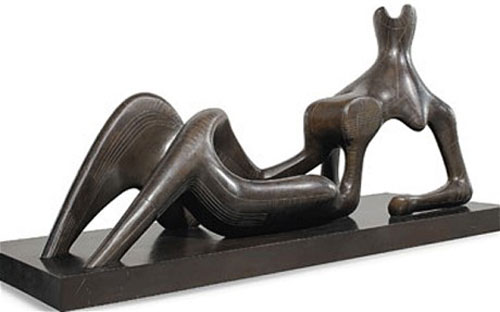
 Sculpture News at SculptSite.com
Sculpture News at SculptSite.com
Henry Moore Sculpture |
| TheTelegraph By Colin Gleadell Modern sales review: when Moore means moreThe £19.1m sale of a Henry Moore bronze nude has put him into the top five of 20th-century sculptors.Henry Moore inched past Lucian Freud last week to become the second most expensive 20th century British artist after Francis Bacon, and toppled Damien Hirst from his position as Britain's most expensive sculptor at auction when his eight-foot bronze, Reclining Figure: Festival (pictured) sold for £19.1 million. This exceeds Freud's $33 million (£17.2 million) record and Hirst's £9.6 million record.* The price also places Moore in the top five of international 20th-century sculptors - above Picasso and trailing only Giacometti, Modigliani, Matisse and Brancusi. This will not surprise those who remember that, 30 years ago, Moore was the world's most successful living artist at auction. In 1982, four years before his death, Sotheby's in New York sold a 6ft reclining figure, made in 1945, for $1.2 million to US collector Wendell Cherry. That sale marked the pinnacle of a career that was nurtured by the British Council, selecting him to represent Britain at the 1948 Venice Biennale and exhibiting his work regularly worldwide. With the encouragement of his dealers, Moore was the first British artist to enter the world of big business, producing monumental bronzes in editions that fed the demand of civic planners and architects internationally for what had become cultural status symbols -symbols of a community's embracing of the modern. But the sheer ubiquity of his work had its drawbacks for critics such as Clement Greenberg, Norbert Lynton and Robert Rosenblum, who felt Moore lost his sharp modernist edge for the sake of mass public appeal. Although a new record of $4.1 million was set in 1990, Moore's market slumped during the recession that followed. Between 1991 and 1995, average prices fell by up to 73 per cent. It was during this period that the New York real estate developer, Sheldon Solow, acquired the Festival figure that he sold at Christie's last week, paying $2 million for it in 1994. Ten years ago, Moore's market began a fitful recovery due to the belief that he was undervalued. But in the last four years, it has been positively bullish. Last November, Art Market Research calculated that average auction prices for the best Moore sculptures had increased by 183 per cent since 2007, with a record £4.3 million ($8.4 million) set in 2008. This would not have taken into account another edition of the Festival bronze that was exhibited by the Lefevre Gallery at the Masterpiece fair in London last summer, priced at $12 million. There are five in the edition, two of which are in museums, and an artist's proof. "People said we were we mad to price it at that level because nothing by Moore had made that much at auction," says Lefevre director, Alexander Corcoran. "But we sold it soon after the fair for close to the asking price. It certainly doesn't look too expensive now." The edition that sold last week for £19.1 million was bought by Alexander Lachmann, a dealer from Cologne who often buys for Russian collectors, notably the Alfa-Bank president, Petr Aven. Russian interest could well have been stimulated by the Henry Moore exhibition to be held in the Kremlin, the first by a modern artist, later this month. Another stimulant could have been the entrance of a powerful new dealer in the Moore market. While it was not unexpected that Montreal's Robert Landau or London's Richard Green were among the buyers of the 18 works by Moore that were offered and sold last week, it was a surprise to see the Gagosian gallery buying Moore's Seated Woman: Thin Neck, and bidding on an eight-foot reclining figure from 1963, which sold above estimate for £3.3 million. The gallery does not list Moore among the long list of successful artists whom it sells, nor does it discuss its future plans, but at least two informed sources have stated that Gagosian is planning a Moore exhibition. While the gallery is not known for creating markets, it does tend to stoke them. London dealer Ivor Braka sees the new Moore record as part of what he calls 'a cliché-driven market', in which wealthy buyers are going for the most familiar works by established artists. Originally commissioned by the Arts Council to celebrate the Festival of Britain in 1951, the sculpture certainly stands out as one of Moore's archetypal images. It may also, as Robert Landau points out, be part of the much broader effect which the private sale of a Cezanne painting for $250 million has had. |
 I was wondering when Henry Moore's work was going to go into the stratosphere, no wondering anymore. It's something that an object that takes up space can be so beautiful in it's design and message that someone was willing to part with £19.1m! This is important as it brings more attention to the value of sculpture to both society and collectors - I for one will sleep well tonight... |
 Henry Moore's Reclining Figure: Festival |
More Sculpture News ....
Submit your SCULPTURE NEWS.
It's easy, just send us an e-mail
(click on Submit News in the left menu) with your pertinent information along with images, we'll take care of the rest. Sculpture makes our world a much better place in so many ways!
SculptSite.com, along with Sculptors and their creative genius all helping to bring the beauty and message of Sculpture to a hurried world.

